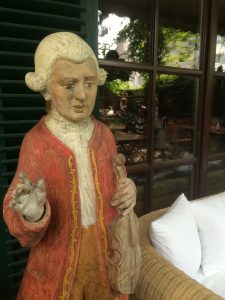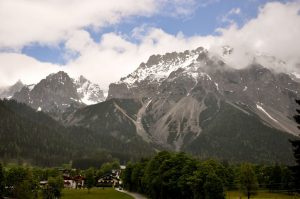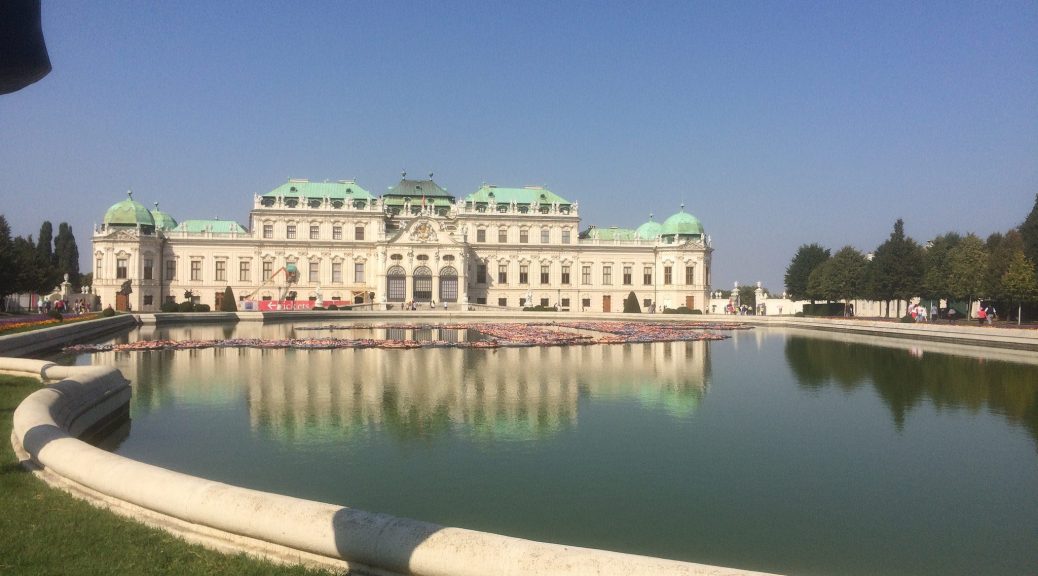Tuesday, September 20, 2016
Guten Abend, all the way from Vienna! We are beginning our third week abroad and our second week of eight in Austria’s capital city. Since you last saw us, we have stuffed our days full of every possible activity our feet could carry us to–from hiking on the Untersberg, to watching a German dress rehearsal of Spamalot, to bussing up the winding Großglockner highway, to admiring cathedral ceilings with craning necks, to navigating the Viennese subway system, to ordering food in our best broken German.
We started our adventure in Salzburg, a cozy little town off the Salzach River with a meager population of 150K. Small, right? The streets are cramped and cobbled, lined with ornate pastel buildings that boast Baroque detailing, and colorful flower boxes in every window. On my first walk downtown, I had a wonderful feeling of being in just the right place.  Everything is old there: the classical culture, the buildings, the families that have lived there for centuries. Our youth hostel, Haus Wartenberg, housed Mozart once upon a time. Everything is green there, too. Haus Wartenberg welcomes as many plants as it does people. The front patio nestled quietly between the 400-year-old building and the garden with overflowing pots guiding your path to the door. Our Haus was not by any means alone in its fondness of all things green and leafy.
Everything is old there: the classical culture, the buildings, the families that have lived there for centuries. Our youth hostel, Haus Wartenberg, housed Mozart once upon a time. Everything is green there, too. Haus Wartenberg welcomes as many plants as it does people. The front patio nestled quietly between the 400-year-old building and the garden with overflowing pots guiding your path to the door. Our Haus was not by any means alone in its fondness of all things green and leafy.
By the end of the week, we felt like we could navigate the streets of Salzburg with ease after wandering them in search of various castles, museums, and ice cream shops all week long. While we stayed there for one short week, Salzburg introduced us well to the basic survival skills of Austrian culture. To save you the trouble of learning the hard way later, I will let you in on a few need-to-knows.
First, never cross the street when the walk light is red. This applies even when there are no cars around to blow their horns if you cross at the wrong time. Austrians love to follow the rules, so breaking even minor ones like this is still taboo. I’ll admit, my rebel side came out once or twice and I crossed anyway.
Second, when you enter a restaurant, do not stand awkwardly in the doorway admiring their fine wallpaper while you wait for someone to lead you to a table. Just go sit down. Then, when you are ready to pay, simply make eye contact with your waiter and say, “Zahlen, bitte!” (Pay, please!). Do not wait for them to notice when you are finished. Restaurants in Austria pay their waiters well, so your waiter will not be concerned about smiling and hovering around your table like most American waiters.
Third, study your Mozart trivia before you come. Austrians love “their” Mozart. In every grocery store you will find towering displays of Mozart balls, the classic fudge-and-marzipan filled delight for any Mozart fan, tourist or not. In Salzburg, you can tour Mozart’s birthplace and see his first violin, original music scores, harpsichord, and stand in the room of his birth. The proprietor of Haus Wartenberg prided himself on a statue of Mozart guarding his front door, insisting that we could not leave until we took a picture with his Mozart.
Finally, expect to know more about The Sound of Music than the locals do. Seek out the 16-going-on-17 gazebo. Climb the Untersberg (or at least take a cable car and then hike the last few miles). Visit Nonnberg Abbey. But while you do these things, I encourage you to take off your tourist hat and see these things from a local’s point of view. Tour Hellbrunn, the site that houses the gazebo, and explore the vast estates of the former archbishop, Markus Sittikus. Good ol’ Mark liked to play tricks on his unsuspecting guests and spritz them with hidden sprinklers. See if you can escape the tour with a dry bum. We didn’t. When you are on  top of the Untersberg, sing about the hills being alive, but also look to your left and notice the structure on the mountain opposite of you. This is Hitler’s Eagles Nest. Realize that if you wanted to escape to Switzerland by climbing every mountain, this particular peak would not be the best choice. While you are in Nonnberg Abbey, sit quietly and listen to the nuns’ voices, really listen to them. The hills in Austria are not the only things that can sing. Look up and admire the Gothic details of the ceiling. Find the Roman frescos on the back wall. Lap up the history of the air around you.
top of the Untersberg, sing about the hills being alive, but also look to your left and notice the structure on the mountain opposite of you. This is Hitler’s Eagles Nest. Realize that if you wanted to escape to Switzerland by climbing every mountain, this particular peak would not be the best choice. While you are in Nonnberg Abbey, sit quietly and listen to the nuns’ voices, really listen to them. The hills in Austria are not the only things that can sing. Look up and admire the Gothic details of the ceiling. Find the Roman frescos on the back wall. Lap up the history of the air around you.
We have been living in Vienna for almost two weeks, now. The difference between these two cities is tangible. If Salzburg is like your floral grandmother who loves to show you her old scrapbooks, then Vienna is your mysterious great aunt who sits by herself, waiting for you to ask the first question. Vienna is a difficult city to get to know, as we quickly discovered. As the capital of Austria, the tourist population does not interfere with city life here as much as it does in Salzburg. People live here, work here, go out for coffee with friends here. When you come in as a tourist, Vienna will show you a particular face: the Baroque facades, the sculptured gardens, the marble statues, the cathedral frescos, the Mozart-costumed salesmen who want to sell you tickets to an “authentic” concert. Yes, this face is beautiful; stunning even. But there is more to this city than pretty old things. Underneath the surface, a current of postmodernism thrives. Turn down any street in the 4th district and you will find graffiti art juxtaposed to the crisp, white windows. Wander through a tunnel off Mariahilferstraße and you will find yourself in a secluded square with brightly colored block seating and cafes all around. Watch a play in German at the Akademietheater, tilt your head sideways and say, “huh,” a few times, and you will experience a “fringe” theater performance like you have never seen before. You have to wine and dine Vienna (or at least take her out for coffee and apfelstrudel) before she will open up to you, but I think we are all okay with this. We have seven more weeks to peel back her layers and figure out what makes this city tick.
Meanwhile, we have started intensive German classes at the American Institute here in Vienna. For most of us, this has been an exciting opportunity to ask the questions we all are dying to know the answers to, such as: How do you say “No onions, please”? or How do I ask “Where is the nearest Billa (a local grocery store chain)”? Or, Do Austrians really go to the theater more than they go to the movies? Our teachers have been boundlessly helpful in showing us around the city and pointing out the best things to do and see. After just one week, we are all feeling a little bit better about our ability to communicate like the locals, though we are well aware we may never have the satisfaction of fooling our waiters into thinking we are Austrian. We have seen two performances so far, Die Präsidentinnen and Dorian Gray and look forward to our first Opera together on Wednesday evening, Strauss’ Salome. At the end of next week, we will travel to Budapest, Hungary, for one of many fun weekend excursions. Things are happening, folks, and we are having a blast.
Auf wiedersehen and adieu, EMU. Keep us in your prayers.
-Liesl Graber

